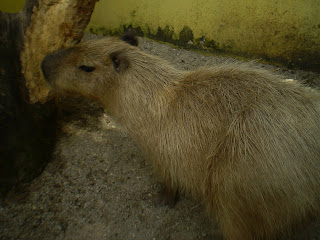CAPYBARA

Scientific name : ‘Hydrochoerus hydrochaeris’
Distribution : South America (including Panama, Colombia, Venezuela, Brazil, Argentina, French Guyana, Uruguay, Peru, and Paraguay
Habitat : Capybaras are semi-aquatic mammals that live in densely forested areas near bodies of water, such as lakes, rivers, swamps, ponds and marshes, such as flooded savannah and along rivers in tropical forest.
Description and Natural History
· Capybaras have heavy, barrel shaped bodies and short heads with reddish-brown fur on the part of their body that turns yellowish-brown underneath.
· Adult capybaras may grow to 130 centimeters (4.3 ft) and 50 centimeters (1.6 ft) tall, weighing up to 65 kg (140 lbs).
· Capybaras have slightly webbed feet and no tail; their back legs are slightly longer than their front legs and their muzzles are blunt with eyes, nostrils, and ears on top of their head.
· Capybaras have 20 teeth.
· Females are slightly heavier than males.
· Capybaras are social animals, usually found in groups between 10 and 30.
· They communicate through a combination of scent and sound, being very vocal animals with purrs and alarm barks, whistles and clicks, squeals and grunts.
Status and Threats
· The population of Capybaras is stable through most of South American ranges, though in same areas hunting has reduced their numbers.
· Capybaras are hunted for their meat and pelts in some areas, and otherwise killed by humans who see grazing as competition for livestock.
· The skins are particularly prized for making fine gloves because of its odd characteristics – it stretches in one direction.
Semalam, zoo negara bawak me and all media melawat zoo to know better about rats sempena Tahun Tikus and this adorable creature (Capybara) is the biggest rats family on earth.



Comments